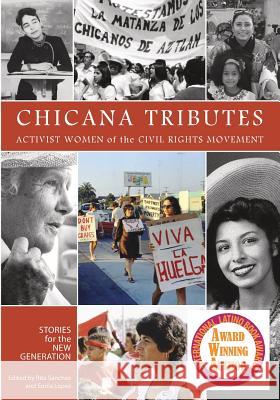Chicana Tributes: Activist Women of the Civil Rights Movement - Stories for the New Generation » książka
Chicana Tributes: Activist Women of the Civil Rights Movement - Stories for the New Generation
ISBN-13: 9780744226348 / Angielski / Miękka / 2017 / 440 str.
Chicana Tributes: Activist Women of the Civil Rights Movement - Stories for the New Generation
ISBN-13: 9780744226348 / Angielski / Miękka / 2017 / 440 str.
(netto: 317,95 VAT: 5%)
Najniższa cena z 30 dni: 335,69
ok. 16-18 dni roboczych
Bez gwarancji dostawy przed świętami
Darmowa dostawa!
This book documents the experiences of sixty-one women who
flourished in the ferment of the civil/ethnic/women's rights movements of the
late twentieth century and beyond. While each life is unique, collectively they
demonstrate the benefits gained when a community and a society unleashes and
fosters the potential of women who create, organize, and lead. Conversely, an
undetermined degree of loss may accrue to societies that suppress or discourage
the freedom of women to shape their destinies.
When women come together with a collective intention, powerful things
happen. Simultaneously, but separately, in 1972-73, at San Diego State University
and at Stanford University, and having never met, two of us had the same idea,
to propose and design a course about Mexican American women. The idea for
this book also has a history. In those days, both of us wanted to contribute to the
development of Chicano studies. The Mexican American voice, so much a fabric
of U.S. history was missing from the dominant English narrative and the women's
presence was nearly absent from Chicano literature and history. Chicanas acted
to change these injustices, thereby adding new energy to the Chicano Movement
and to other liberation discourse. At that time, as graduate students, we had the
opportunity to teach a Chicana women's course.
Such a course had never been taught at either university. While women
instigated change at different colleges, in those years Chicanas/Latinas appeared
to be anonymous. And although Anglo women around the country had already
started addressing women's needs, they did not include the new diverse student
population that was entering the universities.
the woman where she has most noticeably served. Chapters One and
Two begin with Mujeres Presentes, that is, the women who have passed away
but whose presence lives on as their actions continue to affect the lives of others.
Chapters Eleven and Twelve highlight educators whose work builds on that of
earlier mentors and their actions. The chapters between include: Three and Four,
"Early Activists;" Five and Six, "Chicanas in the Arts: " Seven and Eight, "Chicanas
in Education;" Nine and Ten, "Chicanas in Public Office." Each chapter includes
a brief introduction, but the women's narratives are the core of the book; their
stories easily stand on their own.
This collection may be considered a starting point and by no means
represents the entire Chicana/Latina community in San Diego. As it turned out
there were many more women than the sixty-one women presented here. The
hope is that others may read the book and decide to author a future edition. All
women ought to be honored for their efforts and receive the recognition they
deserve.
This book documents the experiences of sixty-one women who
flourished in the ferment of the civil/ethnic/women’s rights movements of the
late twentieth century and beyond. While each life is unique, collectively they
demonstrate the benefits gained when a community and a society unleashes and
fosters the potential of women who create, organize, and lead. Conversely, an
undetermined degree of loss may accrue to societies that suppress or discourage
the freedom of women to shape their destinies.
When women come together with a collective intention, powerful things
happen. Simultaneously, but separately, in 1972-73, at San Diego State University
and at Stanford University, and having never met, two of us had the same idea,
to propose and design a course about Mexican American women. The idea for
this book also has a history. In those days, both of us wanted to contribute to the
development of Chicano studies. The Mexican American voice, so much a fabric
of U.S. history was missing from the dominant English narrative and the women’s
presence was nearly absent from Chicano literature and history. Chicanas acted
to change these injustices, thereby adding new energy to the Chicano Movement
and to other liberation discourse. At that time, as graduate students, we had the
opportunity to teach a Chicana women’s course.
Such a course had never been taught at either university. While women
instigated change at different colleges, in those years Chicanas/Latinas appeared
to be anonymous. And although Anglo women around the country had already
started addressing women’s needs, they did not include the new diverse student
population that was entering the universities.
the woman where she has most noticeably served. Chapters One and
Two begin with Mujeres Presentes, that is, the women who have passed away
but whose presence lives on as their actions continue to affect the lives of others.
Chapters Eleven and Twelve highlight educators whose work builds on that of
earlier mentors and their actions. The chapters between include: Three and Four,
“Early Activists;” Five and Six, “Chicanas in the Arts:” Seven and Eight, “Chicanas
in Education;” Nine and Ten, “Chicanas in Public Office.” Each chapter includes
a brief introduction, but the women’s narratives are the core of the book; their
stories easily stand on their own.
This collection may be considered a starting point and by no means
represents the entire Chicana/Latina community in San Diego. As it turned out
there were many more women than the sixty-one women presented here. The
hope is that others may read the book and decide to author a future edition. All
women ought to be honored for their efforts and receive the recognition they
deserve.











